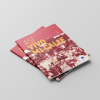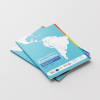During this event, we described the ways in which NAMAs (Nationally Appropriate Mitigation Actions, an instrument to finance climate change mitigation) can be useful in advancing the implementation of sustainable urban development policies.
The event was carried out in a networking format alongside 20 similar events. Participation fluctuated immensely, with a maximum of about 50 participants. The format was deliberately more interactive than many others at the WUF, with questions to and from the audience, as well as round of reflection among neighbors in the audience.
Interestingly enough, while 8 small groups of 2-4 people formed for this activity, many participants left the room when asked to talk to their neighbors; it is unclear whether this happened because they felt uncomfortable with the format, or if they hoped for more information from the experts instead of thinking for themselves.
The initial discussion, hosted by Konrad von Ritter (a consultant from GIZ), included the following panelists:
- Mrs. Janet de Luna Jimenez (Directora General Adjunta, Secretaría de Desarrollo Agrario, Territorial y Urbano (SEDATU), Mexican Housing NAMA
- Mr. Carlosfelipe Pardo (GIZ Consultant, Despacio.org), Indonesian Sustainable Urban Transport NAMA
- Mr. Sithole Mbanga (CEO, South African Cities Network), South African Energy Efficiency in Public Buildings NAMA
- Mr. Johannes Frommann (Senior Advisor, GIZ), Indonesian Solid Waste Management NAMA
The panel participants provided a diversity of opinions and experiences, from the perspective of the national government to the local, through political representatives and technical experts. The specific range of incentives are necessary so that cities voluntarily commit to achieving national climate objectives. These range from empowering cities to raise funds by creating jobs that confront and offset the risks that mayors and other political decision-makers take to be pioneers in low-carbon emissions development solutions.
Main Topics and Key Messages from the Session:
Added Value of the NAMA Process
– This process served as a learning platform to design a complex reform of the sector. It offered a mechanism to create consensus and coordination among the various fragmented initiative. It served as a precursor to housing sector reform (Mexico).
– NAMAs were a catalyst of innovation (Indonesia)
– The results of this process are more important than the quantitative results of NAMAs.
– In addition to construction, transport and waste, another field for V NAMAs could be the strengthening of urban planning efforts, which have great potential to reduce greenhouse gases (GHGs).
– Added value and additional legitimacy to innovate thanks to international expertise.
Types of Incentives granted by the international government to cities under NAMA to commit them to achieving voluntary national climate objectives:
– Money (South Africa): NAMA Fund is in preparation (Mexico, Indonesia).
– Incentives to empower cities to raise their own funds.
– In this context, creating conditions to collect funds (e.g. Para SWM) helps generate income locally.
– In addition to money, in order to spend it in an intelligent and efficient manner, it is necessary to know how to do things (Indonesia).
– The co-benefits can be a significant incentive (e.g. jobs).
– Mayors and other policy makers are taking risks by being pioneers in carbon reduction. The incentives should offset this risk (give the mayor the opportunity to talk about the benefits of mitigation action).
– Intelligent subsides are intimately connected with the desired results. Subsidies should be appropriately differentiated by city size.
– Be careful with the private sector incentives. They can significantly distort the market and do more harm than good.
Role of International Support for Supported NAMAs
– Offer transfer techniques. Connect with recommended international practices.
– Help change mindsets and introduce innovations.
Vertical MRV What are the new and different challenges when we try to involve cities in measuring and reporting GHG reductions under NAMAs?
– The MR project is performed in Mexico e.g. with 2 years of obligatory monitoring.
– Connecting the local MR at a national level is a fairly new topic.
– A key demand under NAMA for participant cities should be access to information that is available but often withheld.
Vertical Cooperation What is the relationship among the different spheres of government? Do they understand one another or do they need a moderator/mediator?
– The relationships are often tense due to conflicting interests and mutual distrust.
– The national government chooses cities for cooperation and participation based on political, as opposed to technical, considerations.
– Direct participation of cities is necessary, as well as in international climate discussions (South Africa).
– For México Eco Casa NAMA, cities have a very limited role, given that the subsidies flow from the national government directly to the manager.
– The role of the provinces is very diverse or unequal, among and within countries. Large cities prefer to interact directly with the national government. The provinces should play an intermediary role.
Conclusions and Perspectives
-For incentives, there has to be a special emphasis on intergovernmental transfers: not to reinvent and build on the experience of decentralization. Empower cities to use their own resources.
– For vertical governments, concentrate on the (often nonexistent) middle, like provinces/states to improve coverage of smaller, less competitive cities. Where necessary, establish an intermediary technical institution, like DIFU in Germany.
– Integrate cities/subnational entities into national climate policies, including incentives, MRV and mechanisms of vertical governance like the National Climate Initiative (NKI) in Germany. This could be a second stage of V NAMAs.
TRANSfer participates in the World Urban Forum discussion:
As part of the event, TRANSfer gave its perceptions of the transport sector and the experience it had developing NAMAs. The main discussion centered on the way in which NAMAs can be used to direct new opportunities (and add value) to transportation policy and the solve problems that would otherwise be very difficult to face.
The fact that NAMAs can be used as a catalyst for new types of projects was mentioned as well. There were topics related to incentives, the role of international organizations, how MRV can be achieved and how cooperation within governmental bodies was developed by NAMAs. Experts from many different sectors (housing, waste management, energy efficiency) participated in the discussion.








Comentarios recientes